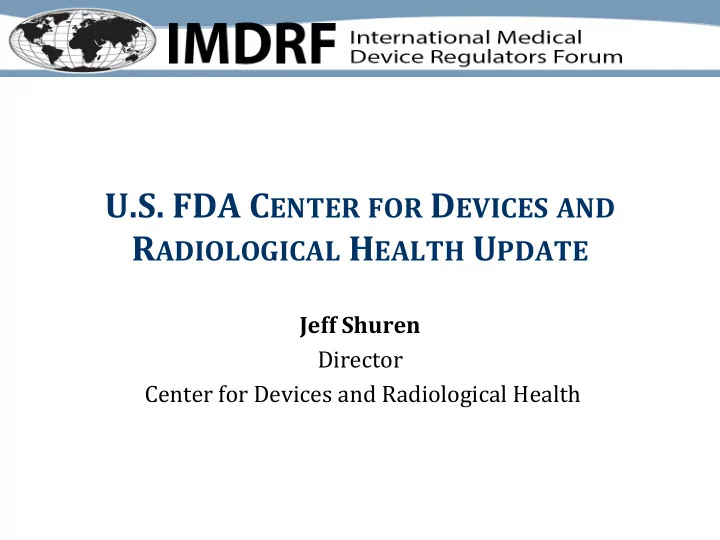

U.S. FDA C ENTER FOR D EVICES AND R ADIOLOGICAL H EALTH U PDATE Jeff Shuren Director Center for Devices and Radiological Health
M EDICAL D EVICE A CCESSORIES – D ESCRIBING A CCESSORIES AND C LASSIFICATION P ATHWAY FOR N EW A CCESSORY T YPES F INAL G UIDANCE Medical Device Accessories – Describing Accessories and Classification Pathway for New • Accessory Types Guidance issued December 30, 2016. http://www.fda.gov/downloads/medicaldevices/deviceregulationandguidance/guidanced • ocuments/ucm429672.pdf The guidance outlines an alternative approach for classifying a medical device accessory based on • the risks it poses when used with the parent device rather than automatically classifying the accessory under the same class of the parent device. This guidance describes a medical device accessory as a device intended to support, supplement, • and/or improve the performance of other medical devices when used together. The guidance describes the current processes the FDA uses to classify medical device accessories, • and encourages manufacturers to use the process that applies when requesting a risk-based classification.
P OSTMARKET M ANAGEMENT OF C YBERSECURITY IN M EDICAL D EVICES F INAL G UIDANCE Postmarket Management of Cybersecurity in Medical Devices Guidance issued • December 28, 2016. http://www.fda.gov/downloads/medicaldevices/deviceregulationandguidance • /guidancedocuments/ucm482022.pdf Cybersecurity is a shared responsibility. • To better ensure the cybersecurity of medical devices once they’re on the market, the • FDA has issued final guidance that outlines steps manufacturers should take to continually address cybersecurity risks with their devices through the use of a risk management approach. This final guidance is part of FDA’s ongoing efforts to ensure the safety and • effectiveness of medical devices as they face potential cyber threats, at all stages in the device’s lifecycle.
F ACTORS TO C ONSIDER R EGARDING B ENEFIT -R ISK IN M EDICAL D EVICE P RODUCT A VAILABILITY , C OMPLIANCE AND E NFORCEMENT D ECISIONS F INAL G UIDANCE • Factors to Consider Regarding Benefit-Risk in Medical Device Product Availability, Compliance and Enforcement Decisions Guidance issued December 27, 2016. http://www.fda.gov/downloads/medicaldevices/deviceregulationandguidance/guidancedocu • ments/ucm506679.pdf • To help maximize patient safety and medical device quality this final guidance clarifies how the agency may assess the benefits and risks of medical devices when making product availability, compliance, and enforcement decisions. • When determining whether or not to take compliance or enforcement action that could directly affect a medical device’s availability, the FDA may consider relevant, reliable information relating to patient perspective(s) and real-world data, in addition to traditional scientific and clinical data. • The guidance may also help medical device companies in conducting their own benefit-risk assessments when evaluating the appropriate response to certain issues, such as determining whether or not to initiate a recall to correct a defective product or remove it from the market.
21 ST C ENTURY C URES A CT : M AKING P ROGRESS ON S HARED G OALS FOR P ATIENTS • 21 st Century Cures Act enacted December 2016 • Device-related provisions: – Combination Product Innovation – Breakthrough Devices – Humanitarian Device Exemptions – Recognition of Standards – Class I and Class II Exemptions – Classification Panels – Non-local Institutional Review Boards – CLIA Waiver Guidance Update – Least Burdensome – Cleaning Instructions and Validation Data – 510(k) Modifications Guidance – Clarifying Medical Software Regulation
M EDICAL D EVICE U SER F EE A MENDMENTS OF 2017 (MDUFA 4) • MDUFA 4 agreement between FDA and Industry reached in August 2016 and recommendations submitted to Congress in January 2017 • Commitment Letter provides for improvements in the following areas: – PMA, 510(k), De Novo, and Pre-Submission Meeting performance – Quality Management – Information Technology • Commitment Letter provides for further development of the following programs: – Patient Input – Real-World Evidence – Digital Health, including: • Aligning software review with software development lifecycles • Continuing our work developing digital health convergence efforts through IMDRF
T HANK Y OU
Recommend
More recommend